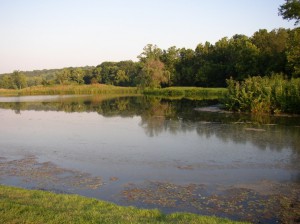
Pond algae is a common problem in a majority of ponds, especially if they are more than 3 to 4 years old. Algae can come in many different shapes and sizes, but the most common is filamentous algae that looks like clumps and float in the water.
All ponds have some algae. They are essential to a healthy pond. However, excessive growth of algae and discoloration of the water may mean that the water quality in the pond is in trouble. Too much algae can also interfere with boating, fishing and even swimming and can cause fish kills if it were to die suddenly. So how can you prevent having too much algae in your pond and how do you treat algae once it has become a problem?
Algae Prevention
An algae “bloom” is when there is an accelerated growth of algae in your pond. This is when the problem will be most easily noticed. By the time you identify that there is a problem, it is usually too late to do anything preventative. There are some short term solutions that we’ll discuss shortly, but the best strategy for pond owners is to keep excessive algae from growing in the first place.
The most common reason why ponds have excessive algae growth is that they have too many nutrients in the water supply. Nitrogen and phosphorus are the two nutrients that cause the most trouble. In a pond, these nutrients are invisible and almost impossible to detect without testing. When these nutrients are combined with sunlight and warm temperatures, algae can easily grow out of control.
Preventing nutrient runoff is one of the first steps to preventing over-fertilization of a pond. Common sources of nutrients are septic tanks, farm fertilizer runoff, livestock and excessive plant or grass clippings. Providing a 10 to 20-foot buffer around the pond with taller vegetation can help filter some of the excess nutrients before they enter the pond. If possible, you should also restrict the amount of fertilizer in areas that run into the pond and keep septic fields away from ponds or below the pond dam where the nutrients can’t leach into your water supply. Trying to restrict nutrients from entering your pond is important, but it is not always enough.
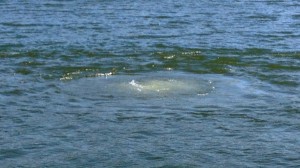
A second source of excess nutrients is a build-up of excess “muck” and organic matter on the bottom of the pond. Many ponds have from 3 inches to as much as 24 inches of black organic matter sitting on the bottom. Unfortunately, this organic matter releases excess nutrients as it decomposes, especially if the pond has a shortage of oxygen in the deeper parts. Breaking down some of that excess organic matter is critical to preventing pond algae long term. So how do you do this? Options include:
- Adding aeration. Pond aeration through a bottom diffuser is the most important thing you can do to help prevent algae long term. Aeration increases the level of DO, or dissolved oxygen, in the bottom part of the pond which increases the number of aerobic bacteria. These bacteria, in turn, begin to feed on the excess organic matter and reduce the amount of nutrients released. More and more people are using aeration as a solution and turning to companies like Outdoor Water Solutions (www.OutdoorWaterSolutions.com) to help them find a solution. This company offers both electric aerators and a new, much improved version of windmill aerators that are extremely cost effective to both purchase and operate.
- Adding beneficial bacteria. Beneficial bacteria work at decomposing excess organic matter, sticks, leaves, decayed fish and excess nutrients. They don’t have to be combined with aeration, but adding oxygen will significantly increase both their numbers and their level of activity at the bottom of your pond where you need them most.
- Another option is to use a combination of beneficial bacteria, a clarifier that helps tie up excess nutrients and possibly a pond dye to help filter sunlight.
- A more radical solution to removing the excessive organic matter is dredging or even draining the pond, cleaning out the bottom and starting over. This can definitely work, but is very expensive. Also, once you clean out the pond, the problems can start all over again unless you take a proactive approach to managing excessive organic matter and nutrients.
Pond Algae Control
Once you have a problem, there are a couple of options for controlling the situation. The most common is to add a copper based algaecide, either in dry or liquid form, to kill the visible algae. You want to avoid not killing too much algae at one time because it will take most of the available oxygen out of the water and you may end up with a fish kill. Most companies recommend treating one-third of your pond at a time. Algaecides can be effective at controlling what you can see, but this does not address the bigger problem. As a result, the algae problem will come back time and again. Killing the algae can also contribute to more and more excess organic matter as when it dies. It will sink to the bottom, adding yet another layer of rich, black organic matter that feeds more algae.
Grass carp sometimes eat algae, but it is not common. They have been seen eating plants coated with algae, but their mouth and gills are not positioned to eat algae effectively. Although grass carp can be used to control some aquatic weeds, they should not be stocked to control algae. In fact, grass carp can add to a nutrient problem and cause algae to multiply if they are no longer eating aquatic weeds efficiently.
The existence of algae in your pond may be a fact of life, but it is good to know that there are ways to prevent excessive growth of it and there are ways to control it with some patience and the right tools.
Aeration Options:
All ponds and lakes will benefit from aeration. Pond aeration is just like adding air to an aquarium. With air, the aquarium stays fairly clean. Shut off the air and it starts to turn green. Adding oxygen to a pond helps aerobic bacteria thrive. They are the lifeblood of a healthy pond as aerobic bacteria are much more effective than anaerobic bacteria at breaking down organic matter and excess nutrients. Bottom diffused aeration brings water from the bottom of the pond to the surface where it comes in contact with sunlight and the wind, which add viable oxygen. This water then goes back down to the bottom where the aerobic bacteria can start to eat the black organic matter and muck on the bottom.
There are several options available for aeration. They include surface aerators, fountains, and bottom diffused aeration using wind, solar and electricity. A description of each is as follows:
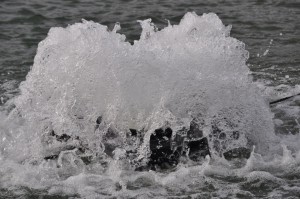
Surface aerators – effective on ponds with higher fish stocking rates. They can add supplemental oxygen needed to keep fish alive in the warmer summer months. They’re not as effective as bottom diffused aeration in circulating the water from top to bottom and eliminating stratification unless the pond is fairly shallow (< 8 feet).
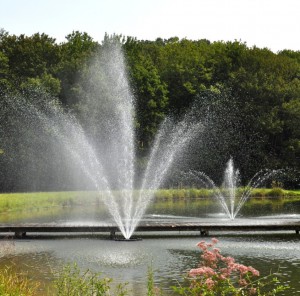
Fountains – they look great but are not really designed for aeration. They can help, especially in shallow ponds but do not add as much oxygen as a surface aerator or bottom diffused aerator.
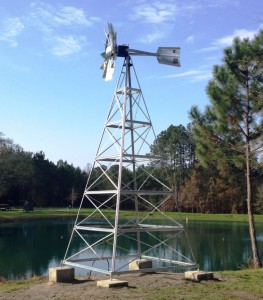
Windmill Aeration Systems – these are great systems for where you do not have electricity or where you don’t want to spend money on electricity. You do need to have access to an area where there’s some wind to turn a windmill. Typically, each windmill will need 3-6 mph of wind to turn. For a windmill to be effective, you would need an average of 6-8 hours of wind each day. On some days, there might not be any wind. On others, you might have 24 hours of constant wind. But, if you can average 6-8 hours a day, you can get enough wind to aerate and circulate your pond.
Electric Aerator
Electric Aerators – There are many good electric aerator options out there if you have access to electricity. You can then aerate 24 hours a day or put the aerator on a timer and aerate 12-14 hours if you want. Most electric aerators are one of three types – linear diaphragm, rotary vane or rocking piston in design.
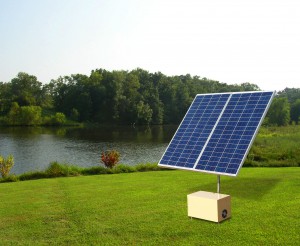
Solar aeration has improved a lot over the last 3-5 years due to lower cost solar panels and better DC compressors. Solar is now an affordable option, especially the new style Direct Drive “DD” aerators that operate during the day by producing a lot of air compared to alternative systems.
The existence of algae in your pond may be a fact of life, but it is good to know that there are ways to prevent excessive growth of it and there are ways to control it with some patience and the right tools.
Outdoor Water Solutions manufactures a wide range of pond and lake products including all of the products mentioned here for algae control. You can learn more at www.Outdoorwatersolutions.com or by calling 1-866-471-1614 for a free catalog.

